After a year of renovation and construction, CERN’s accelerator complex is once again beginning to deliver different beams at a variety of energies.
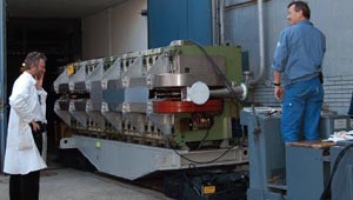
Last year was a time for rejuvenation and building at CERN as a major part of the accelerator complex was shut down while preparations for the Large Hadron Collider (LHC) took place. During the shutdown, which started in November 2004 and continued throughout 2005, the Proton Synchrotron (PS) and the Super Proton Synchrotron (SPS) began an extensive renovation programme that will continue into the next decade. The LHC will depend on the injector complex that feeds it to deliver reliable and top-performance beams when it starts up in 2007. This comprises Linac2, Linac3, the PS Booster, the Low Energy Ion Ring (LEIR) and the PS and SPS.
The programme to renovate the main magnets of the PS, which has been operating since 1959, benefited from the long shutdown. The oldest accelerator of the injector complex had shown signs of its age, going offline for two weeks in 2003 when two magnets failed. The magnets were replaced, but to ensure it is in good condition when the LHC is turned on, the PS and CERN’s other accelerators in the LHC injector chain started a consolidation programme. By renovating parts that are at the end of their useful life and updating obsolete components and systems, the consolidation programme intends to identify and resolve potential problems before operations are affected.
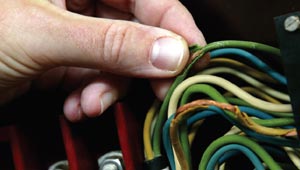
Wear and tear in the PS, which was still equipped with many of its original components, resulted from radiation degrading the materials and mechanical fatigue from pulsed magnetic forces. During 2005, 25 of the 100 main magnets were removed, renovated and re-installed in the PS tunnel. To move the 35-tonne magnets from the tunnel to the workshop in nearby building 180, the 45-year-old PS locomotive was restored. In the workshop, teams from the Budker Institute of Nuclear Physics (BINP) in Novosibirsk, supervised by specialists from CERN, replaced the coils and pole-face windings and re-glued loose laminations. After testing, the renovated magnets were re-installed in the tunnel and re-aligned, ready for start-up in April 2006.
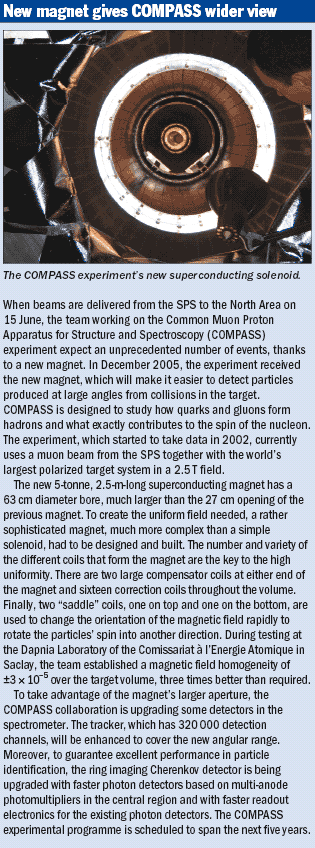
The SPS has also shown signs of age. In 2005, leaks appeared in the hydraulic circuits of some of the accelerator’s dipoles, but after a thorough investigation, a way was found to make repairs. Those repairs and other upgrades will be completed during the 2006-07 shutdown.
New construction
The SPS is almost the last link in the chain that will supply beams to the LHC. The final connection will be made by two transfer lines, TI 2 and TI 8, that will take beams from the SPS. TI 8 was commissioned in 2004, and progress continued on TI 2 during 2005, with components installed and tested up to some 250 m before the shaft where the LHC magnets start the underground journey to their final locations. Upstream of TI 2, the beam extraction in the long straight section of the SPS has been converted into a fast extraction. Four upgraded kicker magnets have been installed to deflect the beam into the gap of existing septum magnets, which bend the beam horizontally out of the SPS ring. New extraction protection devices have also been installed to cope with the high-intensity beam for the LHC.
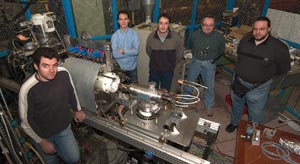
The recent shutdown also allowed time to work on Linac3 and LEIR. Together, they will provide heavy-ion beams to the LHC experiments in 2008. LEIR is the successor to the Low Energy Antiproton Ring and reuses much of the former machine’s equipment. At the beginning of 2005, Linac3 was equipped with a new 14.5 GHz electron cyclotron resonance ion source (ECRIS) to increase the beam intensity. The configuration of the source was based on R&D done under a European Framework 5 project and the source itself was supplied by the Commissariat à l’Energie Atomique, Grenoble. In spring 2005 a beam was transported successfully from Linac3 to LEIR through the transfer line, which had been almost completely rebuilt.
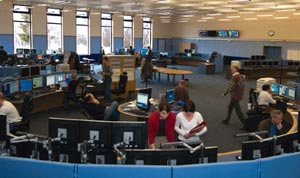
LEIR itself was installed last summer and commissioning began when the first beam (of O4+ ions) was run in October. Preparation then began for the first studies of electron cooling, using collisions with an electron beam in a section of LEIR to reduce the dimensions of the ion beam. This focuses the beam and frees space to accumulate several pulses from Linac3 in LEIR. The cooling system, built by BINP, has been commissioned with electrons and the strong perturbations its magnetic system has on the ion beam have been corrected. The first cooling measurements took place at the end of the 2005 run, and the goal is to complete commissing in 2006.
The new control centre
While various teams worked on improvements needed for different aspects of the LHC’s operation, others were working to bring control of the future accelerator complex together in one room. The new CERN Control Centre (CCC) began operating on 1 February 2006 and was officially inaugurated on 16 March in a ceremony with members of the CERN Council.
The CCC, a sleek, futuristic room filled with a multitude of monitoring screens, combines the control rooms of all the laboratory’s accelerators, as well as piloting cryogenics and technical infrastructures. The new centre has 39 control consoles laid out in four zones, one dedicated to each of the technical infrastructure, the PS complex, the SPS and the LHC. The cryogenics consoles are positioned between the LHC zone and the technical infrastructure zone. During peak operation periods there could be up to 13 operators working on any one shift, not counting the many experts responsible for assisting them. Built and installed in just 15 months, the centre is the first part of the LHC project to start up. The operators for accelerator testing are already on site, as the machines spring back into life.
By bringing together all of the operators and facets of the LHC injector chain, the CCC will guarantee a high-quality beam. It will also manage the beams to other experimental facilities at CERN. Similar to a rail network that uses the same infrastructure to send passengers towards various destinations, the accelerators of CERN can transport several beams simultaneously and adapt each one to a given facility. The PS, for example, can prepare beams for the LHC while also feeding the Antiproton Decelerator (AD) and fixed-target experiments at the SPS. This multitasking is an important feature of accelerator and beam operations at CERN.
Now the machines are all coming back to life. The Isotope Separator On Line facility (ISOLDE) already started operation in April. Serviced by the PS Booster, ISOLDE had run during 2005, when it received record numbers of protons from the booster, as the PS and SPS were not operational. The PS service to the East Hall is scheduled to recommence on 22 May, and the AD should start up on 6 June. As of 15 June the SPS will provide the beam for the North Area, where several fixed-target experiments will be ready and waiting. On 29 May however, a major new project will come to life as commissioning begins for the CERN Neutrinos to Gran Sasso project. This facility will mark a new phase in the 30 years of the SPS when it delivers protons to generate a beam of neutrinos that will travel underground 730 km to the Gran Sasso Laboratory in Italy. It will continue the tradition of neutrino beams at CERN, which began with the PS and then moved to the SPS, and will test the recent improvements to the accelerator complex as the countdown continues towards the LHC start-up.








